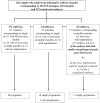Soluble CD146, an innovative and non-invasive biomarker of embryo selection for in vitro fertilization
- PMID: 28291830
- PMCID: PMC5349662
- DOI: 10.1371/journal.pone.0173724
Soluble CD146, an innovative and non-invasive biomarker of embryo selection for in vitro fertilization
Abstract
Although progress was made in in vitro fertilization (IVF) techniques, the majority of embryos transferred fail to implant. Morphology embryo scoring is the standard procedure for most of IVF centres for choosing the best embryo, but remains limited since even the embryos classified as "top quality" may not implant. As it has been shown that i) CD146 is involved in embryo implantation and ii) membrane form is shed to generate soluble CD146 (sCD146), we propose that sCD146 in embryo supernatants may constitute a new biomarker of embryo selection. Immunocytochemical staining showed expression of CD146 in early embryo stages and sCD146 was detected by ELISA and Western-blot in embryo supernatants from D2. We retrospectively studied 126 couples who underwent IVF attempt. The embryo culture medium from each transferred embryo (n = 222) was collected for measurement of sCD146 by ELISA. Significantly higher sCD146 concentrations were present in embryo supernatants that did not implant (n = 185) as compared to those that successfully implanted (n = 37) (1310 +/- 1152 pg.mL-1 vs. 845+/- 1173 pg.mL-1, p = 0.024). Sensitivity analysis performed on single embryo transfers (n = 71) confirmed this association (p = 0.0054). The computed ROC curve established that the optimal sCD146 concentration for embryo implantation is under 1164 pg.mL-1 (sensitivity: 76%, specificity: 48%, PPV: 25% and NPV: 92%). Over this sCD146 threshold, the implantation rate was significantly lower (9% with sCD146 levels >1164 pg.ml-1 vs. 22% with sCD146 levels ≤ 1164 pg.mL-1, p = 0.01). Among the embryos preselected by morphologic scoring, sCD146 determination could allow a better selection of the embryo(s), thus improving the success of elective single embryo transfer. This study establishes the proof of concept for the use of sCD146 as a biomarker for IVF by excluding the embryo with the highest sCD146 level. A multicentre prospective study will now be necessary to further establish its use in clinical practice.
Conflict of interest statement
Figures




Similar articles
-
The Role of the Adhesion Receptor CD146 and Its Soluble Form in Human Embryo Implantation and Pregnancy.Front Immunol. 2021 Aug 26;12:711394. doi: 10.3389/fimmu.2021.711394. eCollection 2021. Front Immunol. 2021. PMID: 34512633 Free PMC article. Review.
-
CD146/Soluble CD146 Pathway Is a Novel Biomarker of Angiogenesis and Inflammation in Proliferative Diabetic Retinopathy.Invest Ophthalmol Vis Sci. 2021 Jul 1;62(9):32. doi: 10.1167/iovs.62.9.32. Invest Ophthalmol Vis Sci. 2021. PMID: 34293080 Free PMC article.
-
High Level of Soluble CD146 In Cerebrospinal Fluid Might be a Biomarker of Severity of Anti-N-Methyl-D-Aspartate Receptor Encephalitis.Front Immunol. 2021 Jun 16;12:680424. doi: 10.3389/fimmu.2021.680424. eCollection 2021. Front Immunol. 2021. PMID: 34220828 Free PMC article.
-
Soluble CD146, a cerebrospinal fluid marker for neuroinflammation, promotes blood-brain barrier dysfunction.Theranostics. 2020 Jan 1;10(1):231-246. doi: 10.7150/thno.37142. eCollection 2020. Theranostics. 2020. PMID: 31903117 Free PMC article.
-
Guidelines for the number of embryos to transfer following in vitro fertilization No. 182, September 2006.Int J Gynaecol Obstet. 2008 Aug;102(2):203-16. doi: 10.1016/j.ijgo.2008.01.007. Int J Gynaecol Obstet. 2008. PMID: 18773532 Review.
Cited by
-
The Role of the Adhesion Receptor CD146 and Its Soluble Form in Human Embryo Implantation and Pregnancy.Front Immunol. 2021 Aug 26;12:711394. doi: 10.3389/fimmu.2021.711394. eCollection 2021. Front Immunol. 2021. PMID: 34512633 Free PMC article. Review.
-
CD146, a therapeutic target involved in cell plasticity.Sci China Life Sci. 2024 Aug;67(8):1563-1578. doi: 10.1007/s11427-023-2521-x. Epub 2024 Apr 9. Sci China Life Sci. 2024. PMID: 38613742 Review.
-
GDF9 concentration in embryo culture medium is linked to human embryo quality and viability.J Assist Reprod Genet. 2022 Jan;39(1):117-125. doi: 10.1007/s10815-021-02368-x. Epub 2021 Nov 29. J Assist Reprod Genet. 2022. PMID: 34845575 Free PMC article.
-
Role of CD146 (MCAM) in Physiological and Pathological Angiogenesis-Contribution of New Antibodies for Therapy.Biomedicines. 2020 Dec 19;8(12):633. doi: 10.3390/biomedicines8120633. Biomedicines. 2020. PMID: 33352759 Free PMC article. Review.
-
Noninvasive Biomarkers of Human Embryo Developmental Potential.Int J Mol Sci. 2025 May 21;26(10):4928. doi: 10.3390/ijms26104928. Int J Mol Sci. 2025. PMID: 40430065 Free PMC article. Review.
References
-
- Harbottle SJ, Hughes C, Cutting R, Roberts S, Brison D. Elective Single Embryo Transfer: an update to UK Best Practice Guidelines. Hum Fertil 2015; 11: 131–146. - PubMed
MeSH terms
Substances
LinkOut - more resources
Full Text Sources
Other Literature Sources
Research Materials

